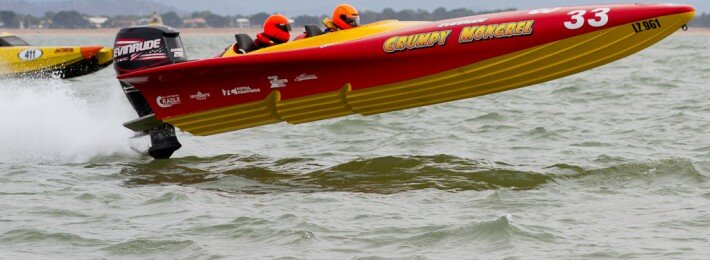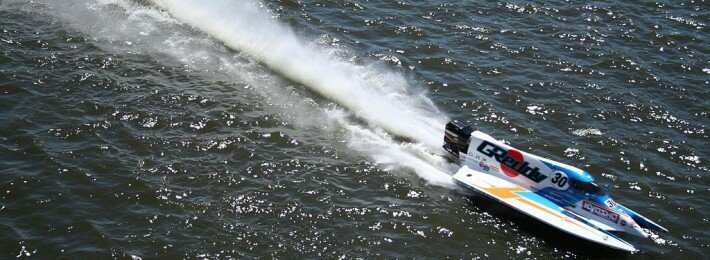Offshore Powerboat Racing Requires Love of Competition and Risk
Offshore Powerboat racing is not for the faint of heart, and as an amateur sport, drivers and captains must keep their life and passion for boating in mind when they go full-throttle on the open water of the Ocean.
Powerboat racing generally involves a point-to-point race where competitors aren’t necessarily in close proximity to each other. An already risky sport would be even more dangerous if the cost of competing included crashing into another high-powered motorboat.
Unlike in year’s past, offshore powerboat racing is relatively affordable, and, unlike Nascar, a million dollars will buy you a full boat (not just a small part of the car). That doesn’t mean it’s cheap, but it’s certainly adventurous and if you crave speed and subsequent heart racing, offshore racing might be your new discipline or amateur sport to follow. Just be careful it doesn’t kill you.
Offshore powerboat racing isn’t some swamp affair with a bunch of rednecks swilling domestic beer in oil-stained overalls. It’s still an amateur sport, but private funding and domestic sponsors make up for the lack of a tried and true professional league. That’s not to say it isn’t organized. In Asia, the Middle East, and Europe the UIM (Union Internationale MotoNautique) regulates the F-1 class and Powerboat GPS of offshore powerboat racing. The UIM is
“…Fully recognized by the International Olympic Committee (IOC), and is also a member of the Sportaccord, the former General Association of International Sports Federations (GAISF) and of ARISF, the Association of IOC Recognised International Sports Federations.”
The UIM is even a part of WADA (the World Anti-Doping Agency), so “Whenever a driver gets drugs prescribed, he must check with his doctor whether or not the drug is on the List [sic].” Don’t use steroids or stimulants in offshore powerboat racing, not that you’d need anything to keep your eyes open while you’re trembling along the precipice of the ocean where every wave might be your last.
In America, drivers and teams alternate between the OPA (which is made up of the UIM, SPI, and APBA) and the OSS, the offshore Super Series formed in 2003 by the top 30 teams in offshore powerboat racing.
Regardless of the sanctioning body of the contest, point-to-point races involve acceleration and speed that is constantly dripping with danger. The possibility of a crash is high, and when you’re traveling anywhere from 60 mph to 250 mph, the slightest touch of the wheel can send you spiraling into the wake and launch the boat into oblivion.
Some of the risks include “over-cooking,” where the boat is going too fast into a corner or is taking the wrong angle, and the boat rolls over. Similar to over-cooking is “hooking out,” where the boat comes into a corner in the wrong spot and it dips over too far and a crewmember is lost or the boat rolls. There’s also the “T-Bone.” That’s when the boat hits a wave and goes too far out of the water and lands on another wave (or boat!), and crashes into the sea.
Not only manmade mistakes account for crashes. Drivers are in open Ocean water, so weather and the choppiness of the sea can upend your boat with one unseen crest of a wave. Think about all the times you went full-throttle in a fishing boat or your little powerboat with friends and hit a wave you didn’t see? You slow down because you don’t want to crash. Now amplify that by 100 and add competition. Sure, maybe you were pulling someone on a jet ski or an inner tube in your boat, but when you’re racing against a competing boat, even a life jacket or a helmet can’t always save you from serious injury or even death.
The death of drivers Mohammed Majid Al Muhairi of United Arab Emirates and throttleman Jean-Marc Sanchez of France in 2009’s Dubai Grand Prix even led some to question whether offshore powerboat racing should even exist. There have been deaths in the sport, and that’s unlikely to change with the inherent risk associated with all extreme sports. Stringent safety measures curtail the actual number of deaths associated with open water powerboat racing. Various injuries include slipped discs and or internal injuries from crashing around inside the interior of the boat or hitting the water.
Powerboat racing is a niche aquatic motor-sport. To participate you need the money and the audacity to get into a twin-piston powered craft that’s coasting along the Ocean at insane speeds. The open Ocean is a powerfully destructive force, and when you combine racing with the elements, there’s a visceral danger. Even calm seas can’t tame the possibility of a crash. Picture Nascar, but with the racetrack actually moving and crashing into the competing cars.
Open water powerboat racing isn’t going away though. As long as people have the money and the love of racing on the water, they’re going to compete in whatever forum is available. It’s up to you if you want to watch with your stomach in your throat. The ethereal glide of a motorboat along the Ocean’s waves is a stunning site to behold, until it goes too fast or jumps too high off a wave and comes crashing to a halt. That’s what makes it so fun for competitors and audiences alike.






Comments